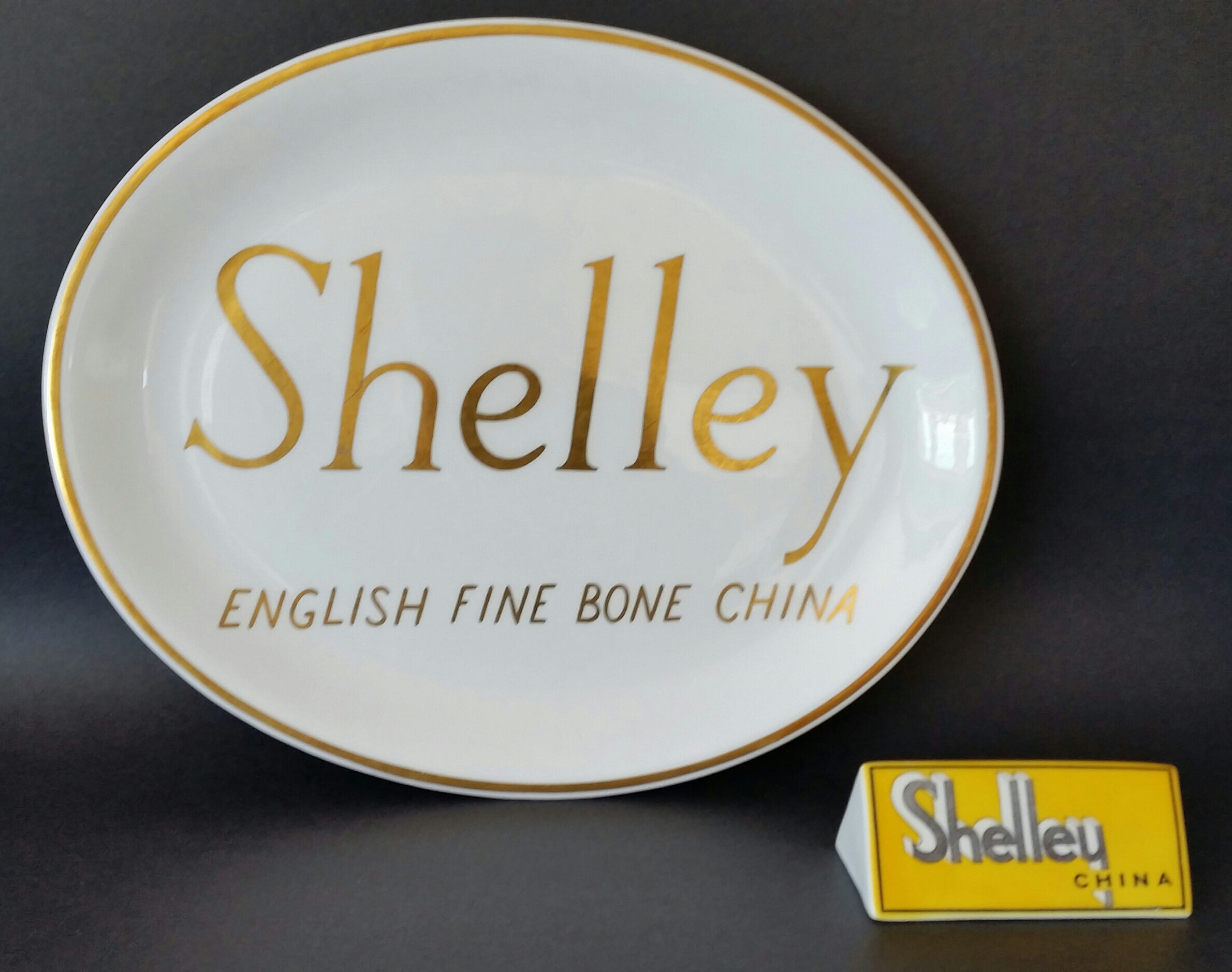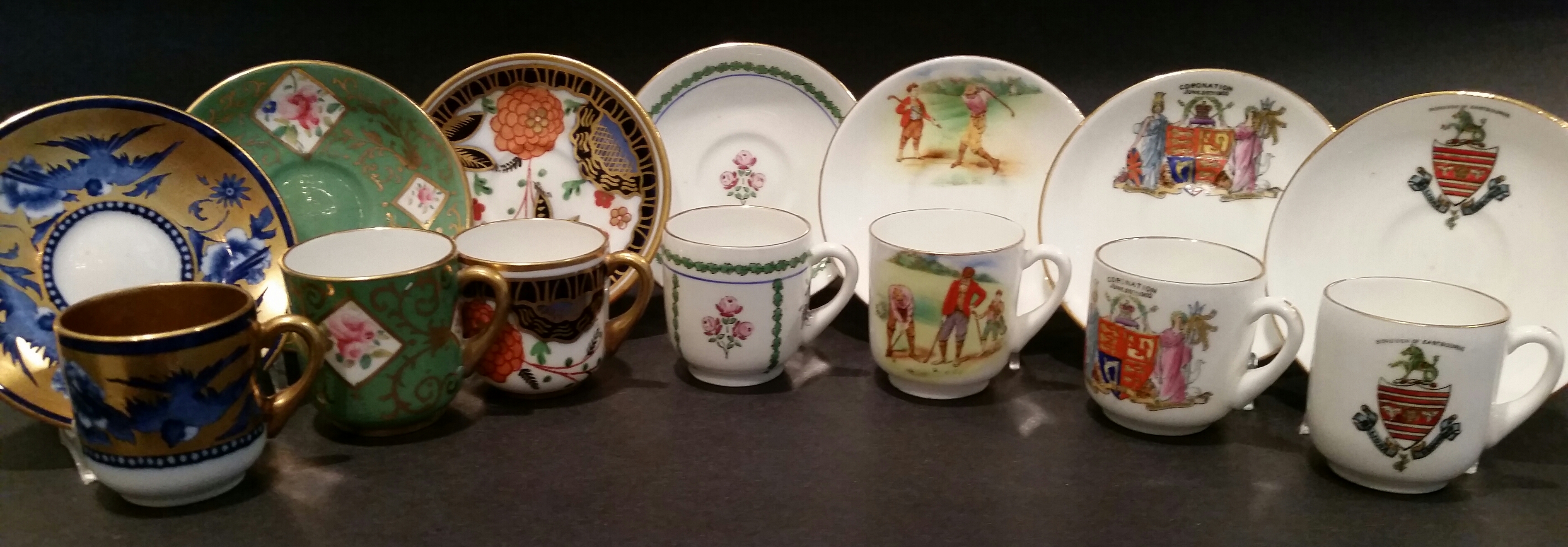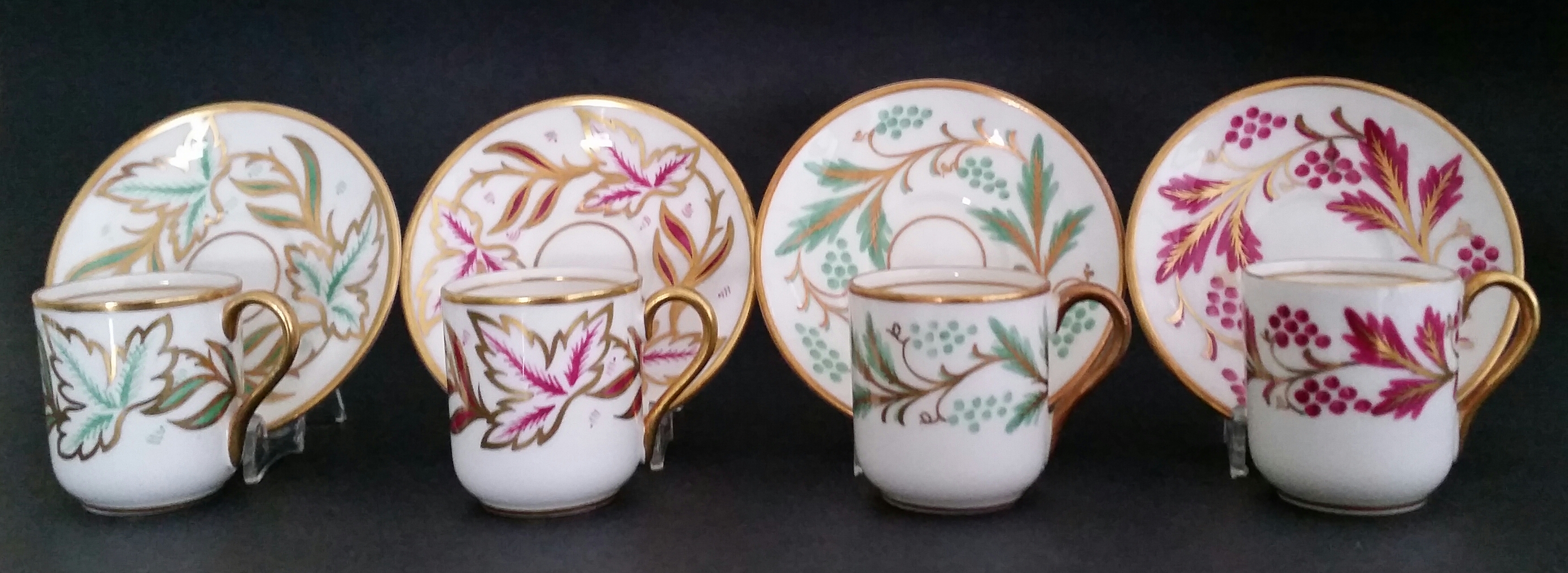Shelley Miniatures

NSCC Member Access
A full pdf copy of these materials is available for download by members in good standing of the National Shelley China Club on the Members Only tab. For information on club membership, please click the Join the Club navigation tab on the left.
Table of Contents
Schedule 1 - Alphabetical List by Pattern Name
Schedule 2 - Listing by Ascending Pattern Number
Introduction/Overview
The following is an effort to provide a comprehensive listing of miniature Wileman/Shelley cups &saucers “verified as existing” as of September, 2017. This compilation is intended as a “work in progress” as miniatures not represented in this listing continue to surface with some regularity. The compilation is presented alphabetically by pattern name (Schedule 1), followed by a listing by ascending pattern number (Schedule 2) & lastly, photos listed alphabetically by pattern name. (Schedule 3)
Wileman/Shelley miniature cups & saucers were produced in four shapes as pictured below from left to right respectively (Figure 1): Gem (cup height 1 ½ in; saucer diameter 3 in), Westminster (cup height 1 ¼ in; saucer diameter 2 ½ in), Canterbury (cup height 1 5/8 in; saucer diameter 2 15/16 in) & Dainty (cup height 1 3/8 in; saucer diameter 3 ¼ in). All measurements in inches are approximate.

Figure 1
Gem, Westminster, Canterbury & Dainty shaped Wileman/Shelley miniatures respectively
Gem shaped miniatures were produced from the mid 1890’s through the very early 20th century. They were primarily souvenir pieces denoting places (cities/universities), occasions (Royal events/milestones) or themes. A small number of Gems produced reflect patterns or portions of patterns found on traditional Wileman ware/cups & saucers. Westminster, Canterbury & Dainty shaped miniatures were produced from the mid 1950’s until 1966. Miniature cups & saucers produced during this period were marketed as souvenirs/mementos/collectables, oftentimes packaged & sold in individual presentation boxes. (Figure2) Shelley China Ltd. was acquired by Allied English Potteries in June of 1966 & production of Shelley wares & use of the Shelley trade-style ended upon the filling of all pending orders.
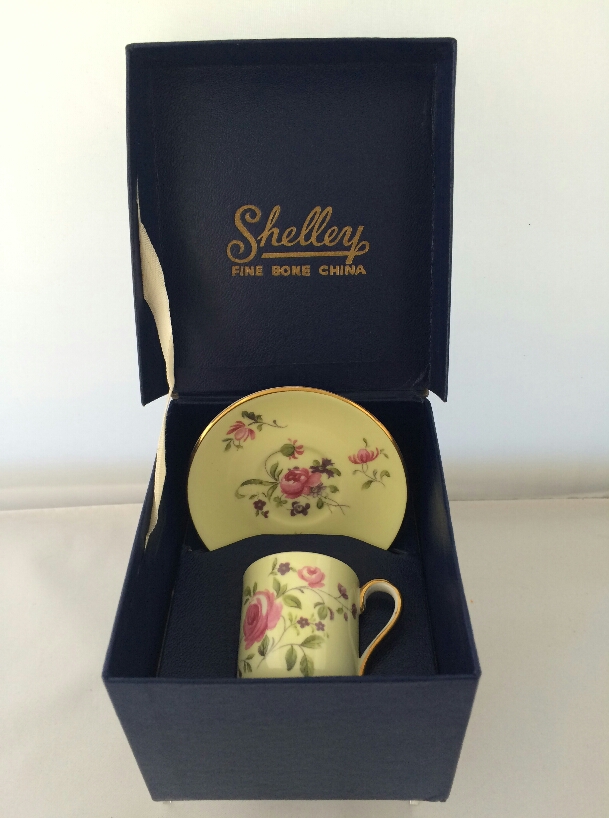
Figure 2
Shelley Canterbury (Lowestoft) miniature marketed & sold as giftware/souvenir
Gem cups & saucers typically bear either the Wileman back stamp of the late 19th & early 20th century with others assigned evolving iterations of the early Shelley shield (Late Foley) back stamp. (Figure 3) In many cases only the cup or the saucer has an identifying back stamp.

Figure 3
Back stamps appearing on Gem shape miniature cups & saucers
Post WWII Westminster, Canterbury & Dainty cups & saucers are usually found with either the Shelley (shield) back stamp with “Fine Bone China” appearing above the mark or simply “Shelley China” without the Shelley shield. In some instances Westminster, Canterbury & Dainty miniature cups & saucers reflect one or the other of these back stamps on the cup & the other on the saucer, or vice versa. (Figure 4) There is speculation as to whether or not matching miniature cups & saucers were produced with differing back stamps or are the result of pairing orphan cups with orphan saucers over the years. Compatible miniature cups & saucers with non-matching back stamps seem of no significance to most collectors & are of no consequence in valuations.

Figure 4
Back stamps appearing as found on Canterbury, Dainty & Westminster miniatures
While there are approximately two hundred “uniquely different” miniature cups & saucers represented in this listing, the feeling by many collectors is that most assuredly, many more may have been produced—both in terms of additional patterns as well as patterns currently verified as produced & possibly appearing on more than one or two of the miniature shapes. Subtle & minor variations in trim & overall pattern applications as well as very slight unintended but discernable background color differentiations within a specifically designated & assigned factory color have not been considered as material for the purpose of this listing nor detailed or included in the count as a unique miniature. (Figure 5)
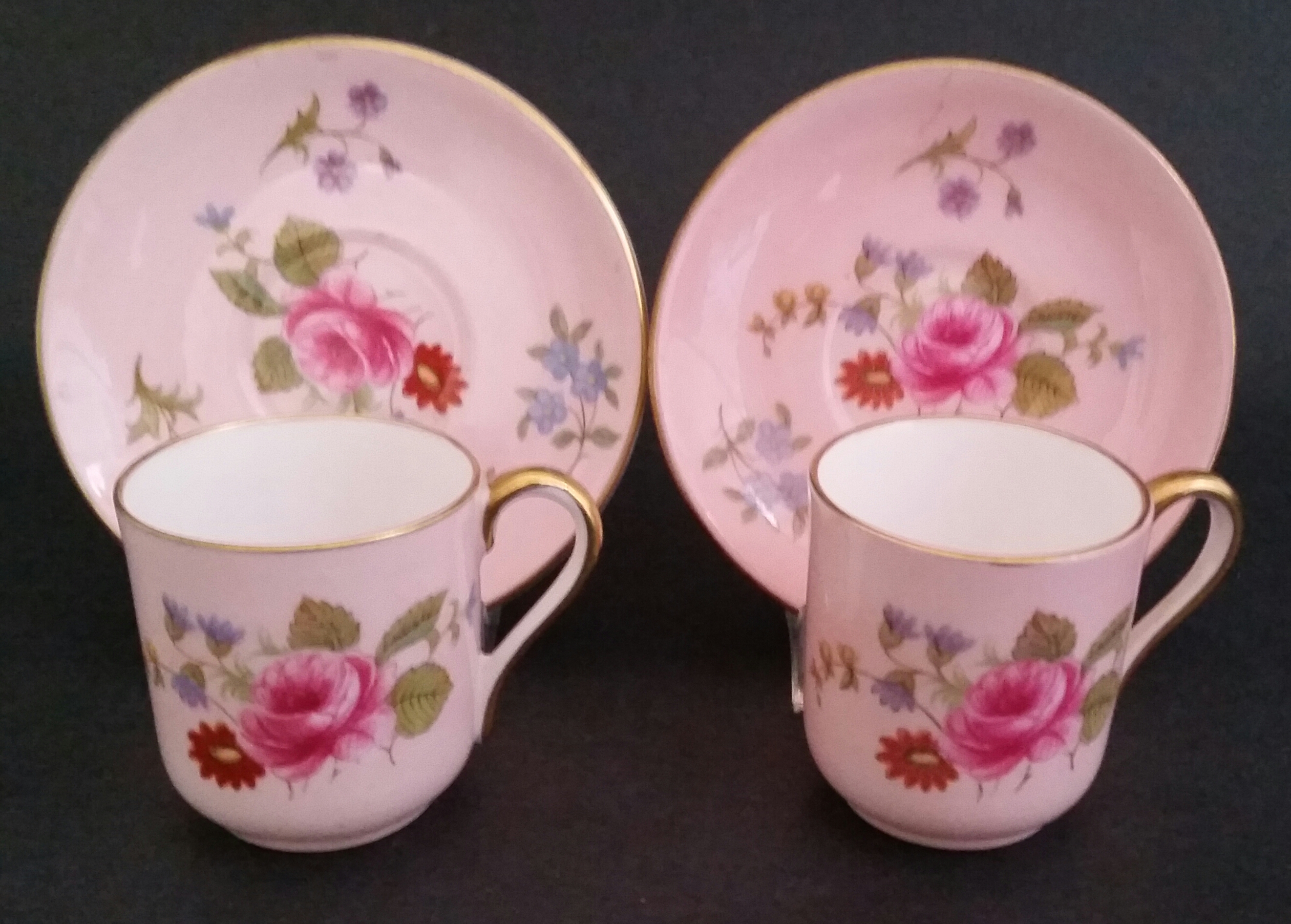
Figure 5
Example of numerous unintended minor/subtle color variations
As an additional example, Shelley assigned six different colors to the Canterbury & Westminster miniatures pictured on the cover page of this compilation. There have been very minor & subtle unintended color & trim variations found on each of the six designated solid background colors applied to these miniatures. If described &“counted,” unintended minor background color variations found on these & numerous others, would distort & artificially inflate the total number of miniatures included in this compilation.
Ongoing discussions continue amongst collectors as to whether or not unintended minor color variances constitute a “unique mini.” Consideration by collectors as to whether or not miniatures with unintended minor factory color & or trim variations should be added to their respective collections, is best left to the interpretation & objectives of the individual collector.
Most importantly, all miniatures with solid color (colour-way) differentiations as intended by Shelley are appropriately included in this compilation. NOTE: “COLOUR-WAY” was the term used by Shelley to describe different solid background colors; “GROUND LAID” was the term used to describe the methodology or process for applying various colors to Shelley wares: per Chris Davenport.
There is considerable conjecture amongst collectors regarding the possible existence of a number of Shelley miniatures. Many collectors & dealers have recollections of having seen, or owned at one time, a miniature not represented in this compilation. Verification by way of a photograph or other documentation is required prior to inclusion of a miniature in this listing. There is continuing speculation for example, as to whether multiple chintz patterns such as Bramble & Davies may have been applied to miniatures or whether a yellow Tapestry Rose or yellow/ivory Summer Glory may have been produced. Collectors are often asked if there may be a Begonia pattern in one or more of the three miniature shapes or if a Dainty Green may exist in a Canterbury or Westminster shape. Is there a Dainty Mauve mini in the Dainty shape, or a Dainty Black in any of the three miniature shapes? There’s always the hope one or more of these will surface.
Photos in this compilation are provided solely to illustrate all specific patterns known to have been applied to miniatures. Miniatures with minor litho application or trim variances (partial gold or solid gold handles on some miniatures for example) have been deemed as not material or relevant & are not included. A few patterns have significant & distinctly different portions of the litho applied to miniatures (e.g. Bramble, German & Lowestoft) & are detailed & included. Additionally, two Lyric Westminster’s bearing different colored trims have been included as an example of a rare factory error made in applying pattern numbers. The green trimmed Lyric shown is erroneously marked with the Harmony pattern number. (Figure 6)
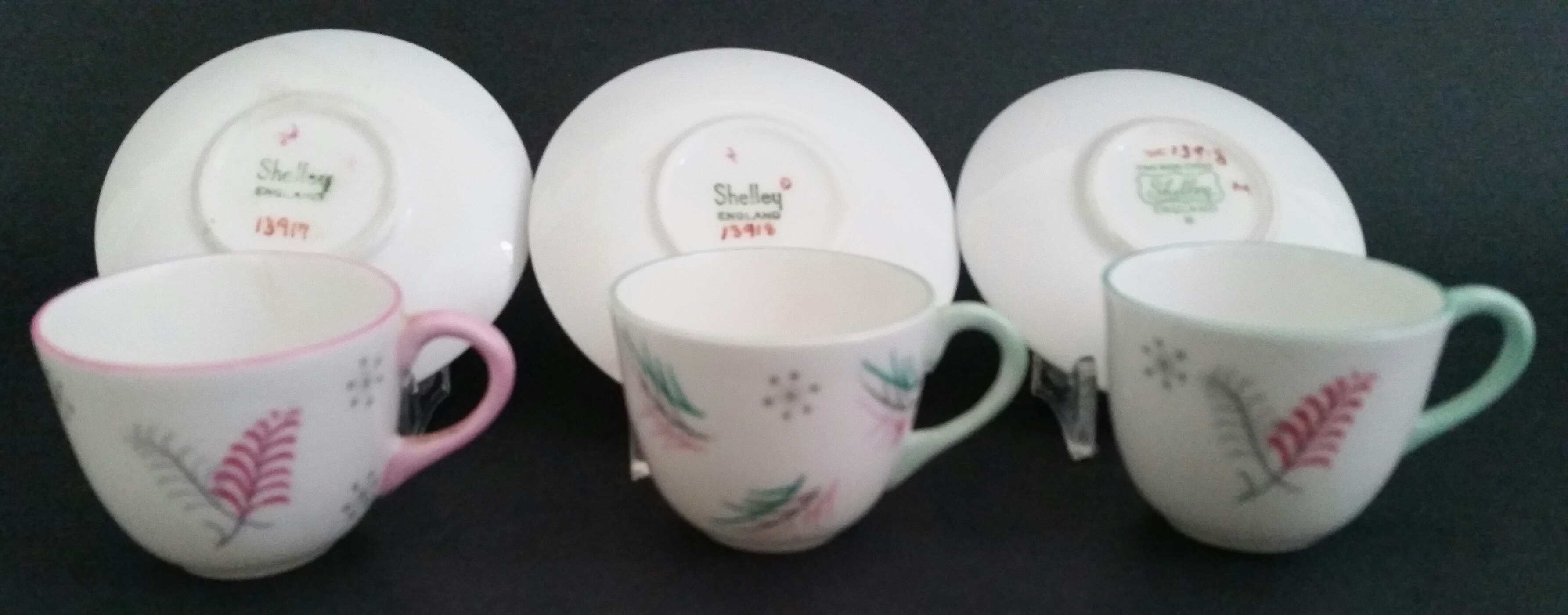
Figure 6
SHELLEY MINIATURE ANOMALY
Lyric Westminster, rare green trim (right) erroneously bearing the Harmony pattern #13918
While all patterns applied to miniatures are pictured in Schedule 3, photos are not provided for all shapes produced in a particular pattern e.g. Charm, the Dainty colors & many others. All known shapes produced in a particular pattern are specifically noted, identified & “included” in the respective pattern descriptions as detailed in Schedule 1.
“After-market” Shelley miniatures have also appeared over the years. Typically they are legitimate Shelley produced “plain white” Canterbury’s with aftermarket hand painted or litho applications. They range from easily discernable amateurish attempts to somewhat professional renditions that upon closer inspection are determined as “aftermarket”. These miniatures are little more than a curiosity to most collectors with minimal market value. (Figure 9)
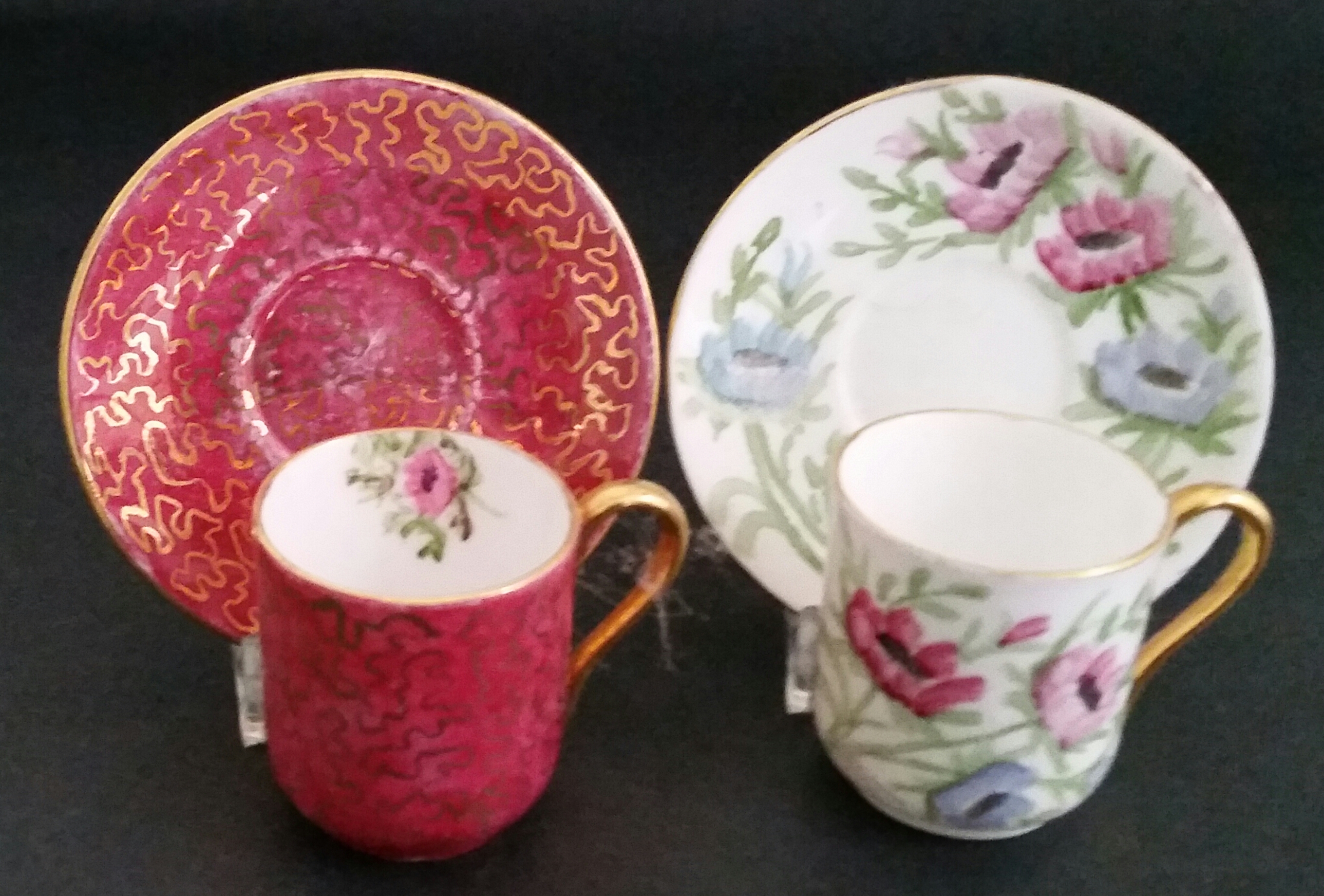
Figure 9
Examples of “aftermarket” Shelley Canterbury miniatures
(Not deemed “collectable” by most & pictured only for information purposes)
PLEASE NOTE: Fellow Shelley enthusiasts & collectors are encouraged to submit additional photographs, information, amplifications & corrections of errors contained herein. Questions regarding Wileman/Shelley miniatures or requests for clarification of any aspect of this listing are welcomed. Simply direct all inquiries & submissions to [email protected].
Schedule 1 - Alphabetical List by Pattern Name
A compilation of Gem, Canterbury, Westminster & Dainty shaped Shelley miniatures listed alphabetically by pattern name, followed by pattern number, description & number of miniature shapes known to have been produced for each pattern. Also noted is the total number of miniatures “verified as existing” for each pattern as designated by “( )”. PLEASE NOTE: Pattern numbers designated with an asterisk*---see Schedule 2 explanation.
To access this schedule, click on the image below.
Selected Gem miniatures depicting various patterns, themes, Royal events & places
Schedule 2 - Listing by Ascending Pattern Number
Pattern numbers designated with an asterisk on Schedule 1 indicate Shelley oftentimes assigned multiple pattern numbers for the same “pattern” to designate pattern applications to various shapes across the full Shelley line and/or other pattern application variables e.g. background colors or trim variations. This in effect renders identification of Wileman/Shelley miniatures by a single pattern number not possible in most cases. Pattern numbers not designated with an asterisk were assigned & appear only on miniatures. Schedule 2 is therefore presented only as an aid in cross referencing pattern numbers listed alphabetically in Schedule 1 with pattern numbers as follows in ascending numerical sequence.
To access this schedule, click on the image below.
CANTERBURY: “VINE LEAF” & “GRAPES & VINE LEAVES”
(Example of two distinctly different patterns, #13616 & #13584, often confused by collectors)
Schedule 3 - Pictorial List by Pattern Name
Representative pictures of all patterns applied to Wileman/Shelley miniatures (See Schedule 1 for detailed descriptions, variations & miniature shapes bearing each respective pattern)
To access this schedule, click on the image below.
Acknowledgements
Acknowledgments may be accessed here.
